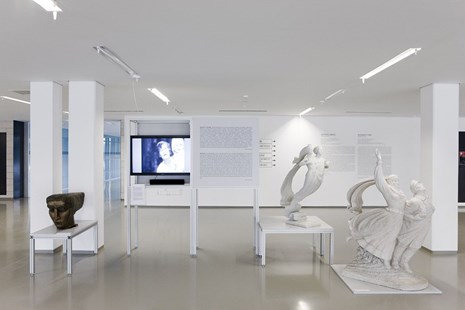Woman's time. Sculpture and Film

Woman's Time. Scuplture and Film
The exhibition Woman's Time is an attempt to re-examine the image of the 20th-century woman in Lithuanian sculpture and cinema. It was inspired by the increased interest in women's creativity and gender issues in art, as well as the prominent role played by women in the country's cultural and political life. Sculpture and cinema are selected as ideologically important media that capture the "spirit of the age". The emphasis is shifted from revealing artistic development and creative individuality to the (de)construction of meanings. It is an attempt to look at woman from the perspective of the contemporary viewer, rather than from that of an artist or a critic. Thus, works by acclaimed figures in Lithuanian sculpture and cinema share the space with pieces that are almost kitsch, yet all of them are records of woman's life at the time.
The selection process was determined by the aim to present public and private roles of Soviet woman, and to demonstrate the connections between them and the modernisation processes of the 20th century. In order to present them, a contrapuntal narrative scheme developing several themes simultaneously was preferred over a linear one. This narrative is distributed across five categories: Heroines, Social Bodies, Private Spaces, Woman as Decoration and Deconstructed. Although the majority of works belong to the Soviet era, there are also several emblematic sculptures from an earlier period that serve as historical references to the themes developed later. The exhibition, on display in the first and second floor lobbies, complements the permanent exhibition of the National Gallery of Art. In the sense of the artistic agendas represented, the exhibition is split into three parts: the prologue (ties with the early 20th century and the interwar period), the main plot (the Soviet heritage), and the epilogue (the modernisation processes of the late Soviet period).
The exhibition's title was inspired by Julia Kristeva's essay "Women's Time", in which she analyses the situation of women in Europe by exploring three notions of time: linear, cyclical and monumental. Linear time is perceived as historical and masculine. Cyclical time is viewed as feminine, linked to the repetitive biological rhythm. Kristeva associates monumental time with femininity, as well. While the essence of cyclical time is "repetition", the essence of monumental time is "eternity". This exhibition does not seek to reconstruct the history of women, but rather to analyze the change in the construct of "woman", as both an idea and an image, itself. The most important is to link the woman to time, and not just to space or the body, as is the tradition in Western philosophy. In the context of this exhibition, the woman is perceived as a stopwatch rather than an image.
Exhibition curators: Elona Lubytė and Laima Kreivytė
Curator of the film program: Živile Pipinytė
Exhibition consultant: Giedrė Jankevičiūtė
Exhibition designer: Julija Reklaitė
Exhibition partners: M. K. Čiurlionis National Art Museum, UAB Lietuvos kinas
Exhibition is supported by the Fund for Support of Culture of the Republic of Lithuania
Exhibition is accompanied by a catalogue


